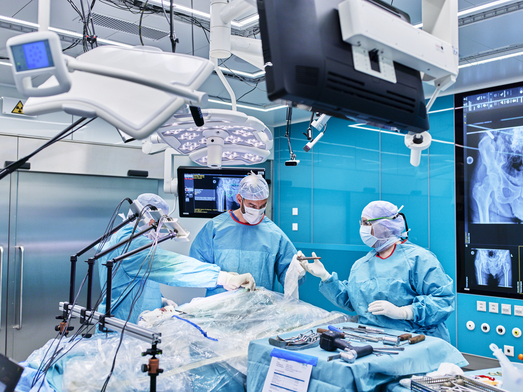From advancing surgical robotics to exploring digital twins for surgery, OR-X has rapidly become a place where significant innovation takes shape. These milestones not only underscore promising technology but also the transformative power of interdisciplinary collaboration. By uniting experts from diverse fields, we’ve fostered progress that transcends individual accomplishments. In the final interview of our series, co-founder Prof. Dr. Philipp Fürnstahl reflects on the pivotal research projects of our inaugural year, the technologies that have propelled our success, and the breakthroughs that inspire continued innovation. Discover how these efforts are shaping the future of surgery.
Shaping Surgical Research: Insights from Prof. Fürnstahl

5 Visionary Reflections from our co-founder

Which major research projects did the OR-X contribute to during its first year, and how would you evaluate the experiences gained?
Prof. Dr. Philipp Fürnstahl: One project standing out was the FAROS initiative, which stands for Functionally Accurate Robotic Spine Surgery. The FAROS research centers on advancing surgical robotics, specifically aiming to enhance robotic autonomy. We were fortunate to host the final validation experiments for the FAROS robotic prototype, which were conducted at the OR-X with great success. These experiments brought together research groups from across Europe, creating a vibrant and collaborative atmosphere. Another significant project is our work on open research data in the OR-X, a government-funded initiative. This project is dedicated to collecting comprehensive surgical data with the aim of optimizing procedures and increasing their efficiency. Both projects exemplify how OR-X serves as a hub for innovative research and collaboration.
Which technological capabilities played a decisive role in advancing these research projects?
Prof. Dr. Philipp Fürnstahl: The OR-X boasts a wide range of advanced research equipment that supports both research experiments and surgical training. Among these are state-of-the-art surgical robots, augmented reality devices, and, perhaps most importantly, a high-performance network infrastructure integrated with NVIDIA's AI servers. Together, these elements form a comprehensive technological ecosystem for surgical research and training, accessible to a wide range of users. Another key factor is the ongoing support provided by the OR-X team. Experiments hosted here benefit from the combined expertise of research and surgical staff, ensuring that both technological and clinical guidance are always available. This unique blend of resources and expertise empowers researchers to carry out complex, interdisciplinary projects with sustained support.
What breakthroughs and successes from the first year of the OR-X are personal highlights for you?
Prof. Dr. Philipp Fürnstahl: From a research perspective, one highlight was certainly the PROFICIENCY project. Over the past year, we had the opportunity to present the first version of our XR-based open surgery simulator at the OR-X to guests and visitors. Additionally, we successfully digitized real surgeries to create digital twins, which now serve as the foundation for immersive surgical education and ongoing research. A third personal highlight was our active participation in various research congresses and summits, including the Swiss Congress of Orthopedics in June and the AI Center at ETH in October, which further solidified OR-X’s role in advancing surgical research.
How did we facilitate collaboration across different disciplines in surgical research?
Prof. Dr. Philipp Fürnstahl: While OR-X features state-of-the-art technological and surgical infrastructure, the real difference lies in the people who conduct their research here. OR-X fosters an environment where individuals from various disciplines can collaborate closely in a highly focused and intensive manner toward a shared goal. To me, this collaborative approach is the core purpose of OR-X – promoting and enabling interdisciplinary collaboration within the field of surgery.
What is your personal wish for the future of the OR-X as a technologically advanced surgical research center?
Prof. Dr. Philipp Fürnstahl: My wish is for the OR-X to emerge as a leading force in computer-aided surgery internationally. I envision the OR-X becoming a central hub for surgical innovation, attracting top-tier researchers and young talents alike, all working toward a common goal: to advance the future of surgery for the benefit of patients.





